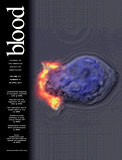Pachlopnik Schmid J, Canioni D, Moshous D, Touzot F, Mahlaoui N, Hauck F, Kanegane H, Lopez-Granados E, Mejstrikova E, Pellier I, Galicier L, Galambrun C, Barlogis V, Bordigoni P, Fourmaintraux A, Hamidou M, Dabadie A, Le Deist F, Haerynck F, Ouachée-Chardin M, Rohrlich P, Stephan JL, Lenoir C, Rigaud S, Lambert N, Milili M, Schiff C, Chapel H, Picard C, de Saint Basile G, Blanche S, Fischer A, Latour S. Blood. 2011 Feb 3;117(5):1522–9. Epub 2010 Nov 30. IF: 10.555

Abstract:
X-linked lymphoproliferative syndromes (XLP) are primary immunodeficiencies characterized by a particular vulnerability toward Epstein-Barr virus infection, frequently resulting in hemophagocytic lymphohistiocytosis (HLH). XLP type 1 (XLP-1) is caused by mutations in the gene SH2D1A (also named SAP), whereas mutations in the gene XIAP underlie XLP type 2 (XLP-2). Here, a comparison of the clinical phenotypes associated with XLP-1 and XLP-2 was performed in cohorts of 33 and 30 patients, respectively. HLH (XLP-1, 55 %; XLP-2, 76 %) and hypogammaglobulinemia (XLP-1, 67 %; XLP-2, 33 %) occurred in both groups. Epstein-Barr virus infection in XLP-1 and XLP-2 was the common trigger of HLH (XLP-1, 92 %; XLP-2, 83 %). Survival rates and mean ages at the first HLH episode did not differ for both groups, but HLH was more severe with lethal outcome in XLP-1 (XLP-1, 61 %; XLP-2, 23 %). Although only XLP-1 patients developed lymphomas (30 %), XLP-2 patients (17 %) had chronic hemorrhagic colitis as documented by histopathology. Recurrent splenomegaly often associated with cytopenia and fever was preferentially observed in XLP-2 (XLP-1, 7 %; XLP-2, 87 %) and probably represents minimal forms of HLH as documented by histopathology. This first phenotypic comparison of XLP subtypes should help to improve the diagnosis and the care of patients with XLP conditions.
-mk-